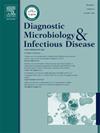Prevalence, genotype distribution, and risk factors of Hepatitis E virus in blood donors, HIV patients, and pregnant women in Southwest Cameroon
IF 2.1
4区 医学
Q3 INFECTIOUS DISEASES
Diagnostic microbiology and infectious disease
Pub Date : 2025-02-13
DOI:10.1016/j.diagmicrobio.2025.116748
引用次数: 0
Abstract
Most HEV infections are self-limiting, but pregnant women in their third trimester and immunocompromised individuals, such as those with HIV, face risks, including fatal liver failure and chronic infection. This study investigates HEV prevalence and genotypes in healthy blood donors and high-risk groups, such as HIV patients and pregnant women, in Southwest Cameroon, where surveillance is limited. A cross-sectional study conducted between March and June 2023 recruited 712 participants: 289 blood donors, 233 HIV patients, and 190 pregnant women. Serum and stool samples were tested for anti-HEV IgG and IgM antibodies using ELISA, and HEV RNA was detected by nested PCR targeting the ORF1 and ORF2 regions. HEV RNA-positive samples were sequenced, and genotypes identified. Among the 712 participants, 7 % tested positive for anti-HEV IgG and 2 % for anti-HEV IgM. Blood donors had the highest anti-HEV IgG prevalence (9 %). No significant associations were found between HEV seropositivity and demographic or dietary risk factors. The overall HEV RNA positivity rate was 1 %, with the highest rates in blood donors (2 %) and pregnant women (1 %), while no cases were found in HIV patients. Phylogenetic analysis revealed that 75 % of HEV RNA-positive samples belonged to genotype 3a, and 25 % to genotype 3e. The nucleotide diversity between human and pig HEV genotype 3 suggests the involvement of environmental or other indirect transmission routes, rather than direct pig-to-human transmission. This study highlights HEV risk in Cameroon, especially among blood donors and pregnant women, underscoring the need for enhanced surveillance in HBV-endemic regions.
求助全文
约1分钟内获得全文
求助全文
来源期刊
CiteScore
5.30
自引率
3.40%
发文量
149
审稿时长
56 days
期刊介绍:
Diagnostic Microbiology and Infectious Disease keeps you informed of the latest developments in clinical microbiology and the diagnosis and treatment of infectious diseases. Packed with rigorously peer-reviewed articles and studies in bacteriology, immunology, immunoserology, infectious diseases, mycology, parasitology, and virology, the journal examines new procedures, unusual cases, controversial issues, and important new literature. Diagnostic Microbiology and Infectious Disease distinguished independent editorial board, consisting of experts from many medical specialties, ensures you extensive and authoritative coverage.

 求助内容:
求助内容: 应助结果提醒方式:
应助结果提醒方式:


